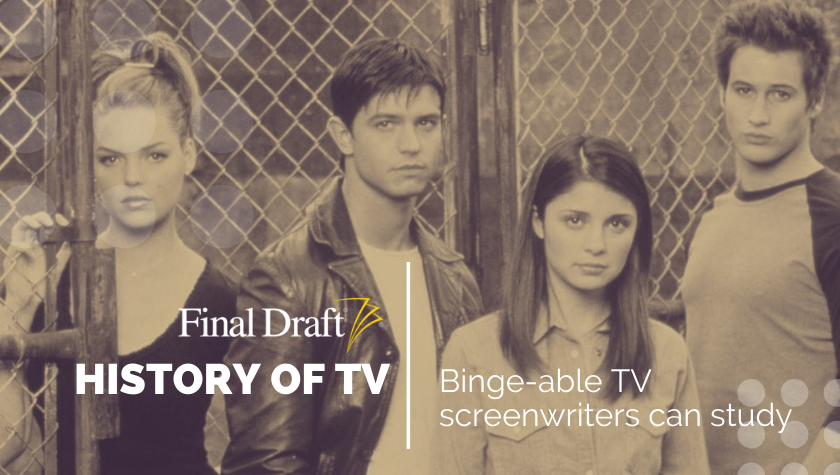History of TV: ‘Star Trek: The Next Generation’ Beams Us To a Whole New World of Understanding
November 5, 2020
Star Trek: The Next Generation is the first show I remember watching weekly. I also distinctly remember being in grade four and a boy named Michael telling me that I wasn’t allowed to like Star Trek because I was a girl. How I wish I’d responded? That I liked superheroes and James Bond, too, and he was missing the point of Star Trek entirely: inclusivity, compassion and understanding. As a shy nine-year-old girl, I said nothing. But I did still wear my toy communicator with pride.
A mix of campy sci-fi elements (thanks to late-‘80s/early-‘90s graphics) schmaltzy love stories, and the occasional phaser battle, Star Trek: The Next Generation was a nighttime drama that seamlessly blended action, sci-fi, soap elements, and cultural commentary. Like the inhabitants of the Enterprise, TNG’s audience was unexpectedly varied and wide for a genre show.
What made it so successful?
The OG reboot
Before Star Trek: The Next Generation was beamed into television sets in 1987, Paramount told The New York Times that the Star Trek property was its “crown jewel”. While the original gained its popularity in syndication, TNG found its audience more immediately and was arguably one of the most successful genre reboots on television. Part of its success could be that the sci-fi serial didn’t strive to be a sequel or a replacement of the original Star Trek series. Rather, it lived in the same (fictional) universe but by its own rules. Finding a show’s own unique voice, even if it’s part of a larger IP, is crucial.
It was also the beginning of studios “maximizing assets” as that 1986 NYT article put it, tying in successful television properties with big screen features, as both the original Star Trek and The Next Generation spawned multiple films after the shows concluded.
But back to that whole voice thing.
Own your niche
A strong voice that conveys the writer’s vision for the show is a good way to set the tone. WE know what we get, just by hearing the words “Star Trek”. But let’s be honest, people rarely know the writers’ names of their favorite shows. Start to round out the portfolio a little (win an award), and maybe you’re getting somewhere. In writer-producer Gene Roddenberry’s case, he created Star Trek and was involved with its successors. NASA named an asteroid after him. While most of us probably won’t ever reach that kind of household name type of fame, what we can take away from Roddenberry’s Star Trek success is that he homed in on writing a certain kind of story; he found his niche and he worked it—with the help of a talented writers room. Let’s not discount the power of teamwork (yet another TNG takeaway).
Spacetime as a story engine
“Space: the final frontier. These are the voyages of the starship Enterprise. Its continuing mission: to explore strange new worlds, to seek out new life and new civilizations, to boldly go where no one has gone before.”
These iconic words delivered by the great Sir Patrick Stewart over the opening titles opened every episode of TNG and instantly let the audience know what they were in for. Great tactic for newcomers to the show, especially for a serial, as well as representative of the show’s themes. The vast, unexplored nature of space makes the setting itself a beautiful story engine that only runs out when the writer’s imagination does.
The dynamics of interstellar travel, as well as the alien species they met, also allowed the writers to play with varied timelines; a tantalizing playground where characters could live out alternate lives. TNG was the perfect nightcap for the human fascination with “what’s out there”, played out safely in our living rooms week after week.
Bigger than life characters
An important element that made this particular Star Trek property so special was its unique mix of characters. Each had the key factors for success: a well-thought out backstory that gave them individual goals as well as unique perspectives within the group. The main crew featured a synthetic lifeform in the form of Data (Brent Spiner), who offered perspective on humanity that was both unabashedly insightful and could hit the right comedic notes. Half-human, half-Betazoid Deanna Troi (Marina Sirtis) appropriately served as the starship’s counselor with her empathy and telepathic abilities. And Michael Dorn’s Worf gave us the most constant and direct insight into one of Star Trek’s fictional species, the Klingons. Then there was Captain Jean-Luc Picard (played by Sir Patrick Stewart). Their fearless leader, and one so beloved he recently received his own spin-off.
The additional sci-fi layer of giving them different alien race backgrounds heightened the themes, action and character dynamics within any given episode. While through a modern lens this is a blatantly obvious allegory for the inclusion and acceptance that we strive for today in both real life and on-screen representation, three decades ago TNG served to bring it into focus.
World building
Before we sign off, let’s not discount the incredible amount of detail that went into creating the Star Trek: The Next Generation universe. While the Vulcans, Romulans, Borg, Q, and others had recurring appearances, hundreds of other fictional alien races—with their appearance, home world, language, technology and culture—were created for only one episode. I think the takeaway here is obvious: there is no amount of detail too small when it comes to creating the world of your story. Who here speaks Klingon? Raise your ghop. The deeper you go, the more your audience can lose themselves in the world you’ve created.
In Retrospect
Star Trek: The Next Generation gave us seven seasons of adventures lightyears away, with characters we could relate to, yet who were living lives so different from ours that we felt transported out of our homes once a week, inspired to explore new world, and maybe new ways of approaching the one we live in.
Written by: Karin Maxey
After seeing her first big screen movie 007: License to Kill at age six, Karin naturally became obsessed with writing action-infused stories. The next time she’d see Benicio del Toro was in person, at the 68th Cannes Film Festival—he was there for the Sicario red carpet, she was there for her first produced short film in the basement of the Palais…same-same. In between, Karin earned a Creative Writing Degree and landed management at Echo Lake Entertainment. Her scripts have been a Big Break Top 3 finalist, HollyShorts Film Fest Official Selection, and a multi-Screencraft competitions semi-finalist. Karin is also a screenplay editor who delights in the process of polishing writers' work for submission. You can find her at www.writergirlkarin.com.- Topics:
- Discussing TV & Film




